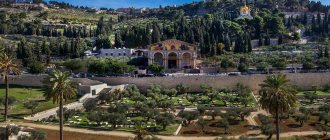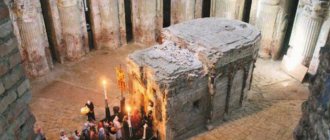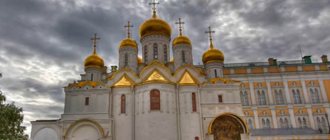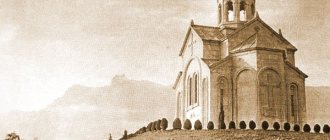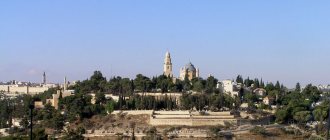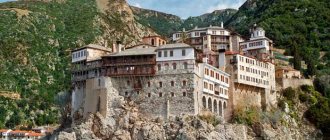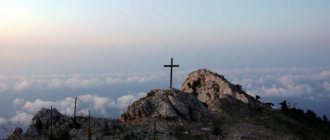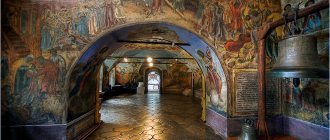Mount Mtatsminda is one of several mountains surrounding Tbilisi. The hill is located almost in the center of the city. Translated from Georgian the name means “ holy mountain”, by analogy with Saint Athos in Greece. Mtatsminda belongs to the Trialeti mountain range, located in the west of the Georgian capital. The hill reaches a height of up to 770 meters, so you can see it from different areas of Tbilisi.
Mtatsminda is home to one of the funicular stations , the Church of St. David , an amusement park , a television tower and much more. There are also several catering outlets here. As one could understand from the name, Mtatsminda is not only the calling card of Tbilisi, but also a religious symbol of historical value. Mention of this place can be found in various works of literature and cinema.
Funicular
Mtatsminda is famous for its funicular, which was built in 1903 -1905. one Belgian company led by Alphonse Roby. The road connected Chonkadze Street and the park on the hill. Mention of it can also be found in works of literature.
Now the funicular has 18 seats and can carry up to 60 passengers. The carriage includes three cabins, each with its own entrance.
From the first cabin when descending or the last one when ascending, you have the opportunity to capture Tbilisi in all its beauty. The route is divided into three stations: lower, pantheon and upper. From the first to the last - 501 meters. Travel time including stops is no more than 10 minutes. The carriage is equipped with maximum convenience for passengers. Each cabin has air conditioning.
You can use the funicular using a special plastic reusable card , which is sold at the first and last stations. Its purchase will cost 2 lari. You can also use it if you are going to ride in an amusement park. A one-way trip will cost 6 GEL , children under 6 can ride for free.
The funicular runs from 9:00 am. You can get to the top station until 23:30. You can go down to the city before the Funicular restaurant closes - until approximately 03:00.
How to get to Mount Mtatsminda in Tbilisi
The ascent to Mount Mtatsminda begins from Chonqadze Street, which, in turn, is located in the old district of the city. You can get to this place by car, following the signs leading to Chonqadze Street, or walk on foot, enjoying the picturesque surrounding views. The most popular way to climb Mount Mtatsminda is, of course, the Tbilisi funicular. You need to get off at its final station with the same name Mtatsminda. Not far from the start of the climb to the mountain there is also the Liberty Square metro station on the M1 line. On the other hand, bus routes number 90 and 124 enter Mount Mtatsminda; their stop is called Mtatsminda Park.
Mount Mtatsminda on Google panoramas
View from the observation deck of Mount Mtatsminda
Video of a trip on the Tbilisi funicular
St David's Church
At the middle station you can get off to visit the pantheon of writers and public figures . It is a necropolis, or simply a cemetery, where many famous natives of Georgia are buried: artists, politicians, scientists, etc.
Nearby is the Church of St. David , which is about a century and a half old. It is a special place for Christians. David Mamadaviti is a monk who lived in the 6th century and was involved in the spread of the Orthodox faith in Georgia.
David of Gareji was born into a Christian family and was left early without parental care. Having become the ward of St. John of Zedazni, he left for Georgia and lived on the same mountain in a cave. On Thursdays, David went to preach Orthodoxy among the townspeople.
One day, David was slandered by a young girl. At the trial it was possible to prove the injustice of the charges. According to legend, the deceiver then gave birth to a stone. The saint prayed to the Lord for forgiveness of the slanderer and asked for help for all women who are unable to give birth due to health problems. In response to this, God showed David three springs with holy water, which has healing powers . This spring is located near the temple.
Where the chapel built by Holy Father David of Gareji was located, the Mamadaviti Temple was erected, which, after being destroyed in the 19th century, had to be rebuilt. On the site of the cave where the monk lived, there is the Temple of the Iveron Icon of the Mother of God. There is also the Temple of the Transfiguration of the Lord and holy springs, which, according to legend, were indicated to David by the Lord.
A couple of steps from the temple there is one of the best observation platforms in Tbilisi, from where you can see the city.
Stories
The idea of building the cathedral arose in 1989 and was timed to celebrate the 1500th anniversary of the independence of the Georgian church and the 2000th anniversary of Christianity. The Patriarchate of Tbilisi announced a competition for the best design of the Holy Trinity Cathedral, in which the work of architect Archil Mindiashvili won.
Due to the collapse of the Soviet Union and the civil war in Georgia, the construction of the temple had to be postponed for a long time. And in 1995, construction of the cathedral on the hill of St. Elijah finally began. Paying tribute to traditions, holy objects were laid in the foundation: stones from Mount Zion and the Jordan River, soil from Jerusalem, and the priests placed gold coins in the foundation of the temple.
The first service in the cathedral took place on December 25, 2002, when the temple was still being completed. Construction was completed in 2004.
Pantheon
The necropolis is located next to the Church of St. David. Heroes of the Georgian people are buried here. The official opening of the cemetery took place in 1929. The first to be buried was the great writer A.S. Griboyedov. In total, there are about 50 burial places of famous Georgian personalities.
In the cemetery you can see the burials and monuments of the following prominent personalities:
- political figure Alexander Chavchavadze ;
- Honored Writer Nodar Dumbadze ;
- famous Georgian poet Vazha Pshavela ;
- artist Lado Gudiashvili ;
- actor Sergo Zakariadze ;
- poet and politician Ilya Chavchavadze ;
- Stalin's mother Ekaterina Geladze and many others.
Griboedov's grave
The outstanding poet-diplomat of the 19th century was buried in Georgia. In the last years of his life, he served as Russia's envoy to Tehran. Literary gift, knowledge of several languages, brilliant career as a diplomat, fortitude and steadfast character of Griboyedov’s versatile personality evoke admiration. As a diplomatic representative of the interests of our country, he insisted on Persia paying indemnity to Russia and the return of Russian captives. However, the losing side categorically refused.
Griboyedov died tragically during the destruction of the Russian embassy by religious fanatics. The poet's body was so disfigured that he could only be identified by a trace of a gunshot wound received in a duel. The funeral took place in Tiflis. Every year, the writer’s grave is visited by thousands of tourists who are partial to his work.
His wife is buried next to Griboyedov. The bodies of the couple rest in a stone grotto. The words belonging to N. Chavchavadze are engraved on the tombstone: “Your mind and deeds are immortal in the memory of Russians, but why did my love survive you?” A bronze figure of an inconsolable woman rises above the tomb where the couple are buried.
Princess Nino became a widow at the age of 17 and mourned her tragically deceased lover until the end of her days. Nino herself died in 1857 during a cholera epidemic.
Mtatsminda Park
Bombora
amusement park is a place that you can’t help but visit when you come to Tbilisi. In addition to the entertainment itself, the park has a lot of greenery - a real piece of forest with all the benefits of civilization. It occupies quite a large area on the hill.
The place where the park is located was popular even among the residents of ancient Tiflis, where they took a break from their worries. This is how a recreation park spontaneously appeared, which was cultivated and rebuilt over time. The official opening of the park took place in 1938. The last large-scale reconstruction was completed in 2007, the park was named “Bombora”.
To get to the park, you need to get off at the end station of the funicular , having previously purchased a reusable card for visiting the attractions. Without it, you won’t be able to fully relax and enjoy the park. You can read above about the cost and where you can purchase it.
You can enter the park for free and do not require purchasing a card; rides cost from 1 to 5 lari. The money is placed on the card from which payment is made. If you do not plan to return to the park, it is better to calculate in advance how much you will spend, since the remaining money cannot be withdrawn from the card. This card also works when paying for a trip on the funicular.
The children's area has a wide variety of attractions and places to play: water slides, a railway, a trampoline, and pleasure trains. Please note that you can visit the attractions or play in the water town only during the summer season.
The atmosphere in Mtatsminda Park is fabulous. The fantasy style prevails in sculptures, cafes and various buildings. There are fairy-tale castles, unusual colorful upside-down houses and figures of famous people. Not a park, but one continuous art object! All the decorations seem to be created in order to return visitors to childhood.
Ferris wheel
Mtatsminda Park's number 1 must-see attraction is the Ferris wheel. Its height is impressive - 62 meters. But the main thing about the ear is not even its size, but the fact that it is located on the slope of a mountain. This provides a stunning view of the capital.
You can visit the attraction in any weather conditions, since the cabins are completely enclosed. However, this does not interfere with the review in any way. Climbing higher, you can enjoy a wonderful panorama of the city. Due to the considerable height of the wheel, the walk turns out to be long, leaving behind a lot of impressions.
Not far from the Ferris wheel on Mtatsminda there is a television tower 274.5 meters high. At night, its multi-colored glow is visible from all corners of the city and beyond.
Ferris wheel
One of the park's attractions that is definitely worth a visit is the Ferris wheel. The wheel is quite large, its height is 62 meters. Its peculiarity is that it is located on a mountain cliff, which offers a fantastic view. The wheel is equipped with comfortable booths with large windows for a good view. Because Since the cabins are completely closed, weather conditions are not at all an obstacle to skiing. As you climb up, the panoramic view of the amusement park, the city spread out below, and the surrounding mountains on all sides opens up more and more. Due to the huge size of the wheel and its slow speed, the walk turns out to be long, very spectacular and impressive.
Next to the Ferris wheel there is a television tower, forming a triangle with its supports. Electricity is not saved in the capital of Georgia, and the tower is not small - 274.5 m, so in the dark, its moving multi-colored lights can be seen almost anywhere in Tbilisi and its environs.
From the Ferris wheel you can walk to an observation deck overlooking the city.
The unforgettable and most delicious Hong Kong waffles are also sold here. You will never pass by the delicious, intoxicating aroma that hangs in the air. Having bought this pimply envelope with all sorts of additives, you can continue your walk or relax on a bench, admiring the panorama of the city lying at your feet or the fountain, which is called the “Wish Tree”.
In the center of the fountain, as if from its jets, a metal tree grows. Its branches and leaves are inhabited by forest dwellers and birds, naturally metallic. The name of the fountain speaks for itself.
Restaurant Funicular
One of the iconic restaurants in Tbilisi is located right at the top funicular station, at the very top of Mtatsminda. It is called “Funicular”. The restaurant is located in a three-story majestic building built in a classical style. Its facade decoration consists of columns and arcades.
All three floors of this majestic building are a restaurant complex. Spacious panoramic terraces offer wonderful views of the city skyline. Perhaps this is one of the most romantic places in Tbilisi - especially at night, when the city shimmers with thousands of lights.
Wonderful cuisine and customer-oriented service also support the level of the restaurant. The Funicular has its own WI-FI. It is not surprising that at any time of the year the restaurant is full of visitors. You can have lunch here and look at the wonderful views of the city from 13:00.
On the lower floor of the building there is a cafe with fresh pastries. The Chela restaurant is also located here , where anyone can get acquainted with the culinary traditions of Georgia. Funicular restaurant welcomes guests on the second floor . Here you can try dishes of both Georgian and European cuisine. On the floor above there is a banquet hall , where you can perfectly celebrate a wedding and other events.
Contacts for more information:
+995 32 298 00 00 / 00
Where to eat in Mtatsminda
The most popular place among guests of the capital is the Funicular restaurant. It is located in the pavilion of the upper station. The cult place has become a real landmark of Tbilisi. The building was restored in 2013. The establishment was repeatedly visited by celebrity clients from all over the world.
Nowadays, from the height of the restaurant's summer terrace there is a stunning view of the city. This place captivates its guests not only with views and a romantic atmosphere, but also with delicious food. Dishes on the menu are presented from both Georgian and European cuisine (donuts and Adjarian khachapuri are popular). The average check of the establishment is $30 per person.
Entree – the cafe is very popular among citizens and tourists. Cuisine: European, American, fast food. Wide variety of dishes. The baked goods are especially good. Local residents often come to Entria to buy bread.
Azarphesha is a wine restaurant that is ideal for a large company. Original Georgian dishes (no traditional khachapuri and khinkali), good atmosphere, large selection of local wine. The average check per person is 20-25 dollars.
The restaurant of traditional local cuisine "Katsi" welcomes its guests with an authentic interior and a cozy atmosphere. Dishes are served in beautiful wooden dishes. The establishment has an extensive wine list and pleases its visitors with reasonable prices. The average check per person is 15-20 dollars, depending on the drink.
Photo Restaurant Funicular on Mtatsminda in Tbilisi
Pantheon (პანთეონი) is the burial place of Georgian writers, poets and playwrights around the Church of St. David of Gareji on Mount Mtatsminda. One of the most famous places in Tbilisi - both in a religious and cultural sense.
In the 5th century, in this place there was a cave in which David of Gareji, one of the Assyrian fathers, settled. He lived in this cave almost all the time, and went down to the city only on Thursdays. At one time there was a popularly revered “St. David’s Path”. I suspect this is modern Besiki Street, although I'm not sure. For a long time the cave was simply a holy place, and in the 19th century a temple was built here. In 1829, Alexander Griboedov was buried near the temple, and just as in his time Raphael created the fashion for burial in the Roman Pantheon, so after Griboyedov it became customary to bury famous people near the Temple of David. In 1929, this place was officially declared a Pantheon. Many revolutionaries and activists of the Soviet era were buried here, which is strange in itself. Later, the communists were reburied in other, less sacred places. Some believe that artists should not be buried in such a place, but the tradition has already been established.
What do we have today
Now on the territory of the Pantheon you can see the same cave of Father David - the Church of the Iveron Icon of the Mother of God was built above it. Nearby stands the Church of the Holy Father David - the largest temple with an apse towards the city. A little further south is the Transfiguration Church, similar to a bell tower. All buildings are brick. Near the temples you can find three holy springs.
On the territory of the Pantheon there are now 48 burials, to the right and left of the Temple of David. If you climb the stairs to the temple, the first thing you see is the grave of Griboyedov and his wife Nino Chavchavadze. If you turn to the right from the temple, the first grave is that of the historian Simon Janashia, in whose honor the Tbilisi Historical Museum is named.
If you go to the back wall, there will be a spectacular tombstone of Ilya Chavchavadze (1837-1907). At the far end is the large black tombstone of Zviad Gamsakhurdia. Died in 1993 in the Mingrelian village of Dzveli-Khibula, buried in Grozny, he was later reburied here.
Probably, few people will pay attention to the not very expressive tombstone to the left of Gamsakhurdia. The white cabinet with the coat of arms is the tombstone of Kaikhosro Cholokashvili (1888-1930), a cavalry general who distinguished himself in the Armenian War, both during the 1921 war, and especially during the 1924 uprising. Reburied in the Pantheon in 2005.
To the left of the Temple of David, the tombstones are not so spectacular, but very interesting in essence. The most important thing is the burial of Ekaterina Geladze, Stalin’s mother. Nearby, according to the strange logic of the universe, is the great man Vazha Pshavela.
| Vazha Pshavela's grave |
Behind the grave of Vazha Pshavela, in the far corner, you can see the original tombstone of the poet Akaki Tsereteli (1840 - 1915). There is no surname, just a name is written on the black stone - “აკაკი”. A little to the right of this grave I discovered something mysterious - a slab with the name Niko Pirosmani:
There is no grave itself, its location is generally unknown, but the slab is there. Very strange.
Regarding the burials at the Temple of David, there is the following passage in the memoirs of Archimandrite Raphael:
Near the temple of St. David there was a cemetery where monks were buried. Then, shortly before the revolution, “outstanding figures” began to be buried there: the cemetery was called the pantheon - the ominous “temple of all gods.” After the revolution, as if in mockery of the shrine, new graves of revolutionaries appeared near the temple - people who challenged God, people whose one of the goals was the destruction of Christianity. Temple arsonists were buried near the temple, like criminals near their victims. Then the site of the former monastery was literally occupied by singers, artists and dancers - people, most of them alien to the Church; they did not go to the temple during their lifetime, and now for some reason they were brought here, to someone else’s house. If you read the inscriptions on the graves, it will seem that there is a theater located near the walls of the temple. In addition, the gaze of believers is offended by the depiction of naked bodies on some monuments. In general, people of culture treated the legacy of the Monk David in a very uncultured manner. ... Blind people, thinking to honor their equally blind idols, brought them to the cave of St. David, not realizing that they were only aggravating the torment of these mostly godless people, that grace is a fire that burns the daring and unworthy. Therefore, the Holy Spirit, descending from Heaven during the Liturgy, blesses only a few graves, and scorches those who lie in the place where the bones of ascetics rested several centuries ago. It would be better for these people to arrange a cemetery away from the shrine. May their tombs be surrounded by the care and memory of their disciples and admirers; if they have merits before the people, let them be given civil honor, but in their very burial near the temple some false notes are sounded.
How to get there
I consider a visit to the Pantheon to be an extremely useful activity and it is logical to do it on the second day of your stay in Tbilisi. This is my subjective feeling. If you find yourself on Rustaveli near the Parliament and the Kashveti Temple, then you can see the building of the Marriott Hotel, opposite which Besiki Street begins. This is the easiest way to the Pantheon.
View of the Temple of David from Rustaveli Avenue at night.
We go up Besiki, pass Griboyedov and Zubalashvilebi, cross Arsena Street, observing its best part on the right, and the worst on the left. Then, in a smooth zigzag, the street leads to Besiki Square, where you can see the statue of Sulkhan-Saba Orbeliani. From here begins the straight Mtatsminda Street leading up and the temple is already visible. Walking along this street, we cross the Chonkadze highway and begin to climb up Mount Mtatsminda. The serpentine leads us straight to the temple.
1. - Simon Janashia; 2. - Niko Brdzenishvili; 3. - Akaki Khorava; 4. — Vakhtang Chabukiani; 5. — Mikhail Chaureli and Veriko Andzhaparidze; 6. - Ushangi Chkheidze; 7. - Sergo Zakariadze; 8. - Lado Gudiashvili; 9. — Dmitry Kipiani; 10. — Solomon Dodashvili; 11 - Vasil Barnovi; 12. — Ilya Chavchavadze; 13. — Olga Chavchavadze; 14. — Ekvtime Takaishvili; 15. — Nino Takaishvili; 16. - Merab Kostava; 17. — Jacob Nikoladze; 18. — Leo Chiacheli; 19. - Shalva Dadiani; 20. — David Eristavi; 21. - Kaikhosro Cholokashvili; 22. — Zviad Gamsakhurdia; 23. — Zakaria Chichinadze; 24. — Simon Chikovani; 25. — Joseph Grishashvili; 26. — Galaktion Tabidze 27. — Georgiy Leonidze; 28. - Nikoloz Baratashvili; 29. — Nino Chavchavadze-Griboyedova; 30 - Alexander Griboyedov; 31. — Akaki Tsereteli 32. — Anastasia Tsereteli; 33. - Vaso Abashidze; 34. — David Kldiashvili; 35. — Vano Paliashvili; 36. — Ilya Vekua; 37. — Niko Muskhelishvili; 38. — Ekaterina Geladze-Dzhugashvili; 39. - ..... 40. - Niko Nikoladze; 41. — Vazha Pshavela; 42. — Alexander Tsagareli; 43. - Mose Janashvili;
Tsminda Sameba on the map of Tbilisi
Coordinates: 41.697510, 44.816666
Tsminda Sameba opening hours: 09:00 – 20:00
You can come any day of the week. Visiting the cathedral is, of course, completely free. For a detailed acquaintance with the temple complex and its main attractions, you will need about two to three hours. But usually, 30-40 minutes is enough.
It is best to start with a tour of Tbilisi and use the services of a guide so as not to miss anything interesting about the history of Tsminda Sameba and its decoration.
What to see near Tsminda Sameba
After visiting the main temple of the country and enjoying the views, you can continue your acquaintance with Tbilisi. The church is located in the old part of the city, making many other attractions within easy reach.
Not far from Sameba is the presidential palace built during the reign of Saakashvili. If after visiting the temple you are heading to the old part or to Freedom Square, then it will be on your way. The main thing is not to get lost in the curved streets of Avlabar. It is worth going around the palace on the right. Then follow the descent to the Baratashvili Bridge.
If you walk along the top of the bridge, you can admire the “youth” sculptures.
If you cross inside the bridge, you can admire the street graffiti gallery. Once upon a time, the walls of the passage were unsightly due to terrible drawings and inscriptions. The city government invited artists and asked them to paint the walls. Walking through it, it is now difficult to resist taking a selfie against the backdrop of beautiful and amazing works.
Also from the bridge there is an excellent view of the Kura River with the Bridge of Peace and the Narikalu fortress. Particularly beautiful panoramic photographs of the city are obtained in the evening and at night when the backlight is turned on.
It is interesting to take a walk in Rike Park; thanks to the abundance of vegetation and flowers, it is pleasant to be here at any time of the year. However, the park is young and recently planted, so there are few shady places in it yet. But there are enough benches, sports grounds, drinking fountains and walking paths, which makes the park one of the favorite recreational places for city residents.
The Bridge of Peace is also definitely worth seeing - this bright structure will not leave anyone unnoticed. The modern bridge in the center of the old town contrasts significantly with the surrounding landscape. Some people like the boldness of the Italian architect’s project, others are outraged by the idea itself - but no one remains indifferent to the bridge.
The cable car starts right in the park and leads to the Narikala fortress . Tbilisi is especially beautiful from a bird's eye view.
The city’s sculptures are also interesting: the monument to Ronald Reagan is very popular in the park, and on Avlabari Square, not far from the metro, there is a monument to the main characters of the famous Soviet film “Mimino” .
